[Cross-posted at Society for Military History Blog.]
An interesting Flickr set of photographs evidently taken in the south of England in the last year of the Second World War was recently posted to a WWII mailing list I’m on. Many show aircraft of various types; others are of people and places. The photographer is unknown but judging from the content was in the US Army Air Forces, stationed at RAF Bassingbourn in Cambridgeshire.
I’ve picked out a few interesting aircraft shots: some are aesthetically pleasing, some show unusual types, and one shows something I’d never come across before. But first is one of a person, perhaps the most intriguing. It shows an unidentified, uniformed woman on a bed: the negative is labelled ‘Xmas Office Party 1 75w bulb overhead f2 25th sec 02’ which says much, but not enough: we are drawn into speculation. Perhaps she has something, or someone, on her mind; perhaps she’s just tired and had a bit too much to drink. It’s unlikely that we’ll ever know, but then that’s what intrigues.
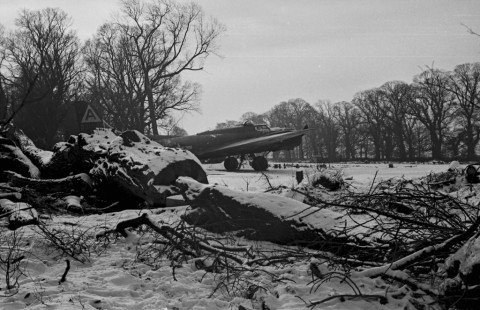
A B-17, Nine-O-Nine, on its way to achieving 140 combat missions without losing a crewman. Nine-O-Nine survived the war (though not the peace); in the foreground are the remains of another machine which wasn’t so lucky.
The B-26 always had a poor reputation, as a dangerous aircraft to fly in. That was largely undeserved by this stage of the war, and it had also proved to be an effective and accurate medium bomber. But surely its most important attribute is its sleek good looks.
By contrast, the P-61 night fighter was a bit of a brute, though a capable one. This is Wabash Cannonball IV of 425th Night Fighter Squadron.
A display of American airpower in the form of at least two squadrons of P-51s with drop tanks. From its tail number, 44-11372, the one at the front is a P-51K of 504th Fighter Squadron.
Another little friend, this time a P-47. The tail number is 44-19575 so it flew with 84th Fighter Squadron.
The unknown photographer also captured a number of British visitors to Bassingbourn. Like Nine-O-Nine, this Lancaster was a survivor: S-Sugar, which completed 137 missions (most of them with RAAF squadrons) and is today preserved in the RAF Museum London. Judging from the number of missions painted on the side, this was taken after the end of hostilities.
Another survivor, but in a different sense. The Stirling was the RAF’s first four-engined bomber, but had largely been phased out of frontline service by 1944 and generally served in more specialised roles. In fact, this one’s role appears to have been quite specialised, and a bit mysterious. from other photographs in this set this machine has the serial number EF403/G. Supposedly the trailing G means it was supposed to be under guard at all times. The squadron markings place it in 1660 Heavy Conversion Unit, but that’s nothing special; nor was the H2S radome underneath the fuselage. It looks like this machine had previously been assigned to the secretive 161 Squadron, which dropped SOE agents into German-occupied Europe; perhaps that explains it.
Another job for Stirlings was towing gliders in airborne operations, like this Horsa. It has invasion stripes, so this was taken in June 1944 at the earliest.
The York transport aircraft did sterling work in the Berlin Airlift and later had some success as a civilian airliner. It was derived from the Lancaster bomber; fortunately for the passengers the fuselage was completely redesigned and much more spacious.
Finally, this is the one that was new to me. Not the machine itself, which is a common Grasshopper observation aircraft, but the mounting of four total bazooka tubes under the wings, for antitank operations and general harassment of the enemy — not a unique modification. As if flying low and slow over the battlefield wasn’t dangerous enough…
Image sources: B-17; B-26; Grasshopper; Horsa; Lancaster; P-47; P-51s; P-61; Stirling; York; and the woman.
![]() This work is licensed under a Creative Commons Attribution-NonCommercial-NoDerivatives 4.0 International License.
Permissions beyond the scope of this license may be available at http://airminded.org/copyright/.
This work is licensed under a Creative Commons Attribution-NonCommercial-NoDerivatives 4.0 International License.
Permissions beyond the scope of this license may be available at http://airminded.org/copyright/.


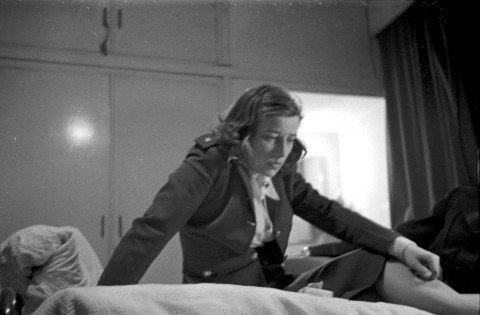

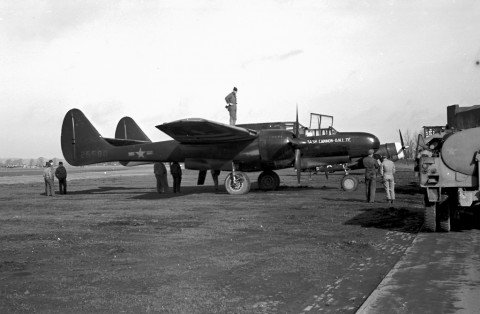
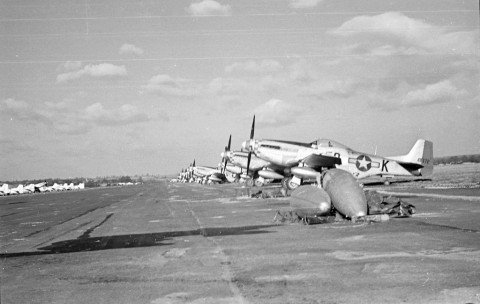

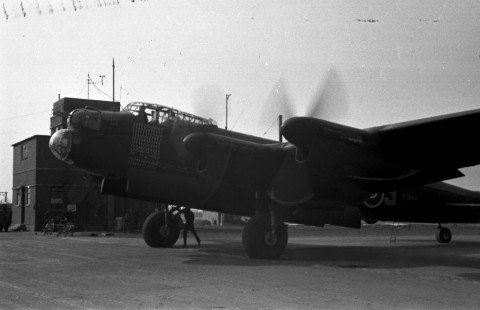
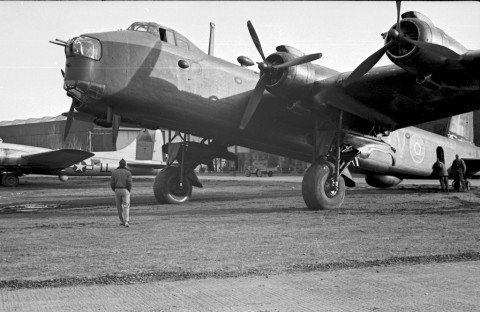


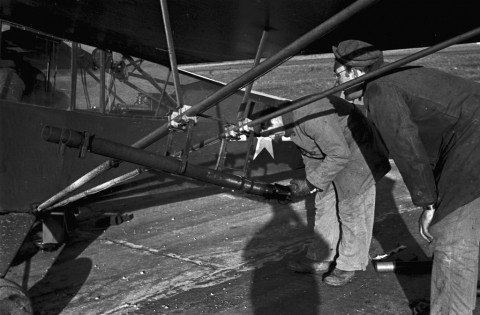
It is an intriguing album, indeed.
We published a couple of images of that Stirling in 2011 in Flightpath magazine, with thanks to Fred Clark, the current owner of the images. The caption I wrote after some research was: “Short Stirling EF403/G was loaned from 214 Squadron to 161 (Special Duties) Squadron to assess the type’s suitability for agent supply and dropping operations, which is why it acquired the serial suffix ‘G’, meaning it was to be kept under armed guard (clearly not the case here!) while on the ground, presumably because of specialised equipment fitted.”
The bazookas on the L-4 are interesting, and also not as unique examples of light spotter agression as you might think. Bücker Bestmanns were fitted with Panzerfausts on the other side, while Cessna O-1 Birddog pilots were keen to have hand aimed M-16 machine guns and the like in Vietnam.
In the US cases, the commanders tended to frown on such things as they were a real distraction from what the observation aircraft were meant to be doing. The cartridge cases found under the floor of my colleague’s Birdddog VH-FXY when it was being restored indicated they were not always successful at reigning in such freelance activities.
[I note this is the third place today that Flickr links are broken. Their redesign woes seem to have become structural.]
The Biafran air force used Swedish high wing trainers with rocket packs attached for low level attacks on Nigerian forces and for dropping supplies.
Apparently the Swedish Count von Rosen suggested equipping Malmö Flygindustri MFI-9B’s with 6 French SNEB 2.68″ rockets under each wing on the grounds that Biafra would never be able to get hold or maintain anything capable of taking on Nigerian MiG-17s in the air, so blowing them up on the ground would be much more practical.
The planes were ‘camouflaged’ by painting with green paint intended for Volkswagens, and I sure a story in an old copy of Flight (which has, obviously, moved from where I left it) described them flying unnoticed beneath MiG-17s to attack Nigerian air bases.
Very interesting about the Bestmanns, Birddogs and MFI-9Bs! It seems there’s a spectrum of military light aircraft being used in ground support roles, from unofficial Birddogs with M-16s through more formal responses to a lack of capability as with the Bestmanns and Birddogs though to dual-purpose trainer/COIN (or light attack) aircraft in many air forces.
JDK:
Which Flickr links are broken? They all work for me (just now, anyway).
Flickr’s been all over the shop as they bring in the ‘new, improved’ enhanced BS model. Links working now, but (for instance) link to comments on one of AnyJazz’s pics still busted.
Count Von Rosen had an interesting career, and his DC-2 was recently restored in Finland. IIRC, the MF-9B story was covered in an Air Enthusiast in some detail.
The MFIs were known as the ‘Biafran Babies’. There are a few bits of a Swedish documentary about them here: http://www.youtube.com/watch?v=LijgAyyGsTo
There’s also a Swedish/English book called ‘Gerillapilot I Biafra’ by Gunnar Hagland.
Thanks, Jerry — clearly I need to brush up on my Swedish…
The ‘Babies’ were interesting, but despite the tech similarity, there’s a difference between extempore upgunning for (essentially) testosterone reasons, vs. best we’ve got with weapons of the Buckers and MF-9Bs. Anyway the L-4 with Bazookas is interesting, but a ‘bad idea’ for the task.
Back to the pics above, I do agree with Brett the signature pic is very haunting, but who knows why, it could just be a pre-hiccup face!
The Avro York is interesting, too. I don’t recognise the insignia on the nose, and whether or not it’s a generic unit one or an aircraft-specific (i.e. VIP) one… Answer’s probably in the Flickr stream comments.
The Airspeed Horsa is probably a reasonable while after June 1944, as the upper surface D Day stripes were being stripped back (as they are here) as time went on and camouflage became more important than air-to-air friendly recognition. The timings of fighter and medium bomber D Day stripe mods are well tabulated, but gliders, I don’t know.
The P-47 is Duxford based; and while the similar bubbletop silver ‘No Guts No Glory’ warbird is no longer with The Fighter Collection (TFC) at Duxford, but back in the States, TFC have a newly-re-restored ‘razorback’ example as part of this year’s ‘Eagle Squadron’ display team. And – ultimate trivia – the wings for that ‘new’ TFC P-47 were redone at Precision Aerospace at Wangaratta, Victoria…
Indeed it is, and it’s said there to be the insignia of 511 Squadron, a long-range transport squadron. It flew the wartime route to Gibraltar — General Sikorski was killed in a 511 B-24 crash.
My father had flown Liberators with Coastal Command (547 Sqdn) in the war, then with 206 Sqdn (Transport Command) afterwards, going mainly to Mauripur in then-India (now Pakistan) – but he left the RAF in early 1946 when 206 was going to get Yorks as he found them far too noisy, he said. He moved to York itself, the city, luckily for me as that’s where he met my mother a few months later.
Very lucky! Also because it’s a nice place, though I can’t speak to the late ’40s version…
The Second World War would have been the first time there were really significant numbers of people travelling long distances by air, though there would have been a drop-off after the war (and of course there were still many more going by sea). It would be interesting to see a time series of global air passenger miles.
Don’t know if you’ve seen this – some great aircraft photos in color from the 1940s:
http://www.flickr.com/photos/library_of_congress/sets/72157603671370361/with/2178404545/
Thanks, TF, will have to have a browse through that.
YAQW. There’s a lot of material to go through (many empty landscapes) but there are several series of aircraft in flight, manufacturing plants, and air bases you may find interesting. Lot of good studies – even the obviously posed ones – of individuals “at work” around aircraft.
The LoC set is a fascinating collection, but is the work of two US organisations, and only features American ‘CONUS’ material. As the header to the Flickr stream says;
“United States Farm Security Administration (FSA) and later the Office of War Information (OWI) created the images between 1939 and 1944.
…
The FSA/OWI pictures depict life in the United States, including Puerto Rico and the Virgin Islands, with a focus on rural areas and farm labor, as well as aspects of World War II mobilization, including factories, railroads, aviation training, and women working.
…
For more information about the collection and to see the approximately 171,000 black-and-white photos, visit: http://www.loc.gov/pictures/collection/fsac/ “
Great as the FSA & OWI images are, the are well known and well used, for the most part, while the diversity of this post’s privately taken images of RAF Bassingbourn in American use is, for me, part of the attraction, and it was good to arrange for a couple to be published in print, too!
JDK:
Feel free to plug it!
When I first saw the picture of the girl on the bed, I was gripped by her eyes. Her eyes seem to speak of such bottomless grief … and in 1944, that makes us think of horrors beyond bearing.
Unfortunately, I then viewed the rest of the series on Flickr and found that it spoiled the illusion for me. You see, in the couple of shots both immediately before and after this, she clearly has a cigarette [1] in her right hand. And in one of the ones just after, she is taking a drag, and the tip glows; so the cigarette is burning. Yet in this picture, she has her right hand thrust hard onto the coverlet or blanket — so she is carelessly burning a hole in someone’s bed!
So I am now inclined to think that she is, in fact, just very drunk. Damn my eyes.
___
1. Actually I’m not completely convinced that it isn’t a “reefer”. This impression is even stronger for the cigarette held by “Fisher’s girl.” They may be just badly hand-rolled cigarettes, but, well, there are some pretty stoned looking expressions in this series … I really don’t know how improbable it is that US airmen in the UK in 1944 would be using cannabis (or rather, giving it to their girlfriends), but it certainly was available before the war, and typically used in the form of reefers. It was rare before the war, but then hemp production was greatly increased during it.
Yes, I saw those other photos of her too, and maybe cheated a little bit by not pointing them out. I think it’s interesting how easy it is (it was my initial reaction too) to jump to the conclusion that she is haunted by some unfathomable loss; but when you do look at the other ones it does seem just as possible that she’s had too much to drink. As another example, a recent newspaper article is headlined ‘Unseen World War One photos reveal the true horror of war’ but it’s hard to see how, given that the only one published just shows a group of soldiers in a trench or dugout, posing for the camera, some of them even smiling. We know that war is hell, therefore nothing must deviate from that narrative.
Just a little note regarding the cigarette. It’s a commercial cigarette, the packet is visible by her leg in the discussed image and better visible in ‘xmas party f2 1 75 watt overhead 05’. Given it’s an ‘xmas party’ it’s be a very odd one if there was no alcohol involved; no need to look further for explanations.